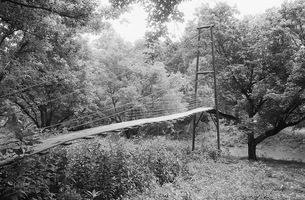 | Back to e-WV
| Back to e-WV
 The West Virginia Encyclopedia
The West Virginia Encyclopedia
 | Back to e-WV
| Back to e-WV
 The West Virginia Encyclopedia
The West Virginia Encyclopedia

Built without benefit of formal engineering design, the swinging bridge is a distinctive form of folk or ‘‘vernacular’’ construction, well-suited for pedestrians crossing streams in the rugged Appalachian region. Swinging bridges were common landmarks for many decades, and are still often seen in the West Virginia countryside.
Using cables, planks, and timbers, swinging bridges could be constructed quickly and cheaply to provide access to homes or farms isolated by streams. Cables composed of wire rope, or indeed, even ordinary hemp rope, were suspended from towers on each bank, with the backstays firmly anchored in the ground behind the towers. These towers, which raised and supported the cables, were made of timber, stone, or steel. The bridges reflected their environment in the materials used and the skills employed in their construction. Sometimes towers made of surplus pipe from the oil fields and used wire rope from mines and other industries formed the essential components of a swinging bridge. The wooden bridge deck was supported by ropes, wires, or rod suspenders hanging from the cables. The parallel cables themselves often formed convenient hand rails.
Although such bridges are strong enough to support foot traffic, they lack stiffness and swing from side to side and vertically under foot traffic, hence the name. Perhaps hundreds of swinging bridges once served West Virginians throughout the state, with many still in service. However, there are few records of the location and distribution, let alone the span length and other details, which are available for other bridge types. As utilitarian structures adapted specifically for their location, many swinging bridges have an appealing form, as much a part of the rural landscape as local barns, corn-cribs, tool sheds, and houses.
Written by Emory L. Kemp